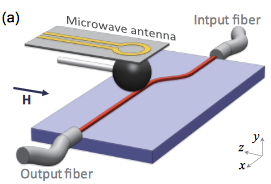
Go to a particular spot outside the Oyster Bar in New York’s Grand Central Terminal, and murmur very softly into the corner. Dozens of feet away, you can still be heard clearly. It’s known as a whispering gallery, a phenomenon in which sound waves of certain frequencies travel along curved surfaces (St. Paul’s Cathedral in London – in illustration below - has the earliest known example).
It’s known as a whispering gallery, a phenomenon in which sound waves of certain frequencies travel along curved surfaces (St. Paul’s Cathedral in London – in illustration below - has the earliest known example).
Researchers in the lab of Hong Tang, Yale’s Llewellyn West Jones Jr. Professor of Electrical Engineering & Physics, have taken the concept of the whispering gallery – using light waves instead of acoustic ones - and applied it to a device known as an optomagnonic resonator. The innovation could lead to a way to efficiently convert information from microwave photons to optical waves, which can be transmitted over optical fiber over very long distances, and open up new possibilities in quantum communications.
The results appear this week in Physical Review Letters. Xufeng Zhang, a Ph.D. student in Tang’s lab, is the lead author.
Magnons - the smallest unit of measurement for a magnetic spin excitation – hold great promise as an information carrier in quantum systems. That’s partly because magnons can simultaneously interact with multiple different types of information carriers including microwave photon, optical photon, acoustic phonon, etc. This is important since one of the greatest challenges in developing complex hybrid systems is realizing an efficient microwave-to-optical conversion to get the benefits of both.
This system uses a sphere of yttrium iron garnet (YIG), a ferromagnetic material that works simultaneously as a low-loss medium for magnons, microwave and light. YIG has been widely used in magnetic and microwave systems before, but this is the first time it has been used to support an optical whispering gallery mode, in which the light is confined along the circumference of the YIG sphere. Since light passes through the sphere multiple times, the researchers could significantly increase the magnon-light interaction.
 “Although the sphere is commonly used in microwave devices, people never thought about using it in an optical resonator,” Zhang said.
“Although the sphere is commonly used in microwave devices, people never thought about using it in an optical resonator,” Zhang said.
To send light in and out of the YIG sphere, the researchers used a silicon nitride waveguide. Conventionally, scientists use tapered silica fiber for this purpose. Because the light can’t get in and out the YIG sphere efficiently, however, the whispering gallery mode can’t be observed. Because silicon nitride and YIG have a similar refractive index, which guarantees efficient light coupling between the YIG sphere and the waveguide, the whispering gallery modes show up clearly in the spectrum of the transmitted light.
Zhang said the next step for the innovation is to improve the magnon-to-photon conversion efficiency by means such as reducing the YIG sphere size to further concentrate the optical and magnon modes, and doping the material to increase the interaction coefficient.
Other authors of the paper are Na Zhu and Chang-Ling Zou, both in Prof. Hong Tang’s lab.
Top image: Light interacts with magnons in a YIG sphere optomagnonic resonator and changes its polarization. (Illustration by Xufeng Zhang)
Source: Yale SEAS News